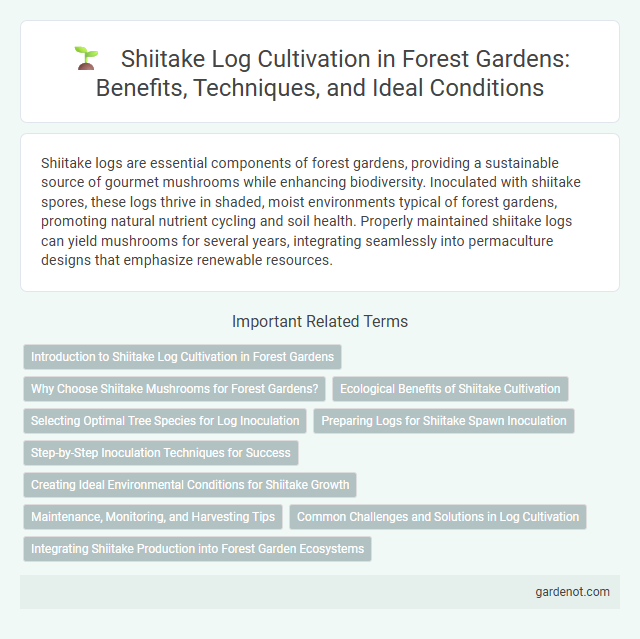Shiitake logs are essential components of forest gardens, providing a sustainable source of gourmet mushrooms while enhancing biodiversity. Inoculated with shiitake spores, these logs thrive in shaded, moist environments typical of forest gardens, promoting natural nutrient cycling and soil health. Properly maintained shiitake logs can yield mushrooms for several years, integrating seamlessly into permaculture designs that emphasize renewable resources.
Introduction to Shiitake Log Cultivation in Forest Gardens
Shiitake log cultivation in forest gardens utilizes hardwood logs, primarily oak or maple, inoculated with shiitake mushroom spores to create a sustainable food source. The logs are typically cut during the dormant season, then drilled and filled with spawn before being incubated in shaded, moist environments that mimic natural forest conditions. This method supports biodiversity, enhances soil health, and provides a continuous harvest of nutritious shiitake mushrooms over several years.
Why Choose Shiitake Mushrooms for Forest Gardens?
Shiitake mushrooms thrive on hardwood logs, making them an ideal choice for forest gardens where natural decomposition processes enhance soil health and biodiversity. Their ability to break down tough lignin and cellulose enriches the ecosystem, promoting nutrient cycling and supporting surrounding plants. Cultivating shiitake logs contributes to sustainable forest management by utilizing fallen or cut logs, reducing waste while producing a high-value, nutrient-rich edible mushroom.
Ecological Benefits of Shiitake Cultivation
Shiitake log cultivation enhances forest garden biodiversity by providing habitat for beneficial fungi and decomposers, which improve soil health through nutrient cycling. This method promotes sustainable wood use by utilizing fallen hardwood logs, reducing waste while fostering fungal growth that suppresses plant pathogens. Integrating shiitake logs increases carbon sequestration and supports natural pest control, contributing to resilient and ecologically balanced agroforestry systems.
Selecting Optimal Tree Species for Log Inoculation
Selecting optimal tree species for shiitake log inoculation significantly impacts mushroom yield and quality, with hardwoods like oak (Quercus spp.), maple (Acer spp.), and beech (Fagus spp.) demonstrating superior compatibility. These tree species provide dense, nutrient-rich substrates that sustain mycelial growth over extended periods, ensuring productive fruiting cycles. Properly seasoned logs from these hardwoods, typically harvested during dormancy, enhance colonization rates and reduce contamination risks in forest garden shiitake cultivation.
Preparing Logs for Shiitake Spawn Inoculation
Select fresh, healthy hardwood logs such as oak, maple, or sweetgum, ideally cut within two weeks to a few months for optimal moisture content. Drill holes spaced evenly about 6 inches apart along the log's length and circumference, then insert shiitake spawn plugs or sawdust spawn, sealing each hole with food-grade wax to prevent contamination. Store inoculated logs in a shaded, humid environment with good airflow to encourage mycelium colonization and eventual mushroom fruiting.
Step-by-Step Inoculation Techniques for Success
Shiitake log inoculation requires drilling evenly spaced holes, typically 1 to 1.5 inches deep, into freshly cut hardwood logs during dormant seasons for optimal fungal growth. Premium shiitake spawn plugs are inserted into these holes and sealed with food-grade wax to retain moisture and prevent contamination. Maintaining logs in a shaded, humid environment with consistent moisture ensures successful mycelium colonization and robust mushroom production.
Creating Ideal Environmental Conditions for Shiitake Growth
Shiitake logs require a shaded, humid environment with temperatures ranging between 55degF and 75degF to optimize mycelium colonization and fruiting. Maintaining 60-80% humidity and ensuring adequate air circulation prevents contamination and supports robust mushroom development. Positioning logs on well-drained soil or raised platforms enhances moisture retention while reducing the risk of fungal competitors.
Maintenance, Monitoring, and Harvesting Tips
Shiitake logs require consistent moisture levels, ideally maintaining 60-80% humidity to support optimal fungal growth and prevent drying. Regular monitoring for contamination by competing fungi or pests ensures a healthy yield, while shading the logs helps regulate temperature and reduce stress on mycelium. Harvest shiitake mushrooms when caps are fully expanded but before edges curl upward, typically 6-12 months after inoculation for the first flush, and maintain logs by soaking them in water for 12-24 hours between fruiting cycles to stimulate production.
Common Challenges and Solutions in Log Cultivation
Shiitake log cultivation often faces challenges such as contamination by competing fungi, maintaining optimal moisture levels, and protecting logs from pests. Contamination can be minimized by selecting freshly cut hardwood logs and sterilizing tools before inoculation. Regular monitoring of moisture and shading the logs can prevent drying out, while barriers or natural predators help manage insect and rodent interference.
Integrating Shiitake Production into Forest Garden Ecosystems
Shiitake log cultivation enhances forest garden ecosystems by utilizing dead hardwood logs, such as oak or maple, to mimic natural fungal growth processes. Integrating shiitake mushrooms supports biodiversity by promoting nutrient cycling, improving soil health, and providing a sustainable source of edible fungi. This method aligns with permaculture principles, fostering symbiotic relationships between trees, fungi, and understory plants, thereby increasing overall ecosystem resilience.
Shitake log Infographic

 gardenot.com
gardenot.com